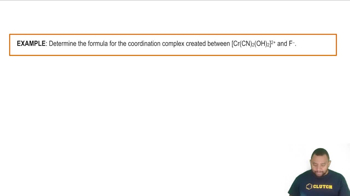For each of the following pairs, predict which substance possesses the larger entropy per mole: (a) 1 mol of O2(g) at 300 °C, 0.01 atm, or 1 mol of O3(g) at 300 °C, 0.01 atm
Ch.19 - Chemical Thermodynamics
Chapter 19, Problem 41c
Predict the sign of the entropy change of the system for each of the following reactions: (c) 3 C2H2(g) → C6H6(g)
 Verified step by step guidance
Verified step by step guidance1
Identify the states of matter for the reactants and products. In this reaction, both the reactants and the product are gases.
Count the number of moles of gas on each side of the reaction. For the reactants, there are 3 moles of C_2H_2(g), and for the product, there is 1 mole of C_6H_6(g).
Compare the number of moles of gas on the reactant side to the product side. A decrease in the number of moles of gas generally indicates a decrease in entropy.
Consider the molecular complexity. Although C_6H_6 is more complex than C_2H_2, the significant reduction in the number of gas molecules is the dominant factor affecting entropy.
Conclude that the entropy change (ΔS) for the system is likely negative because the reaction results in fewer moles of gas, indicating a decrease in disorder.

Verified Solution
Video duration:
59sWas this helpful?
Key Concepts
Here are the essential concepts you must grasp in order to answer the question correctly.
Entropy
Entropy is a measure of the disorder or randomness in a system. In thermodynamics, it quantifies the number of ways a system can be arranged, with higher entropy indicating greater disorder. Understanding entropy is crucial for predicting the spontaneity of reactions and the direction of energy flow.
Recommended video:
Guided course

Entropy in Thermodynamics
Molecular Complexity
Molecular complexity refers to the number of atoms and the structural arrangement within a molecule. In the given reaction, three molecules of ethyne (C2H2) combine to form one molecule of benzene (C6H6). This change in the number of molecules can significantly affect the entropy of the system, as fewer molecules typically lead to lower entropy.
Recommended video:
Guided course

Coordination Complexes Example
Gibbs Free Energy
Gibbs Free Energy (G) is a thermodynamic potential that helps predict the direction of chemical reactions and phase changes. It combines enthalpy and entropy into a single value, allowing for the assessment of spontaneity. A reaction is spontaneous if the change in Gibbs Free Energy is negative, which is influenced by both enthalpy and entropy changes.
Recommended video:
Guided course

Gibbs Free Energy of Reactions
Related Practice
Textbook Question
953
views
Textbook Question
Predict the sign of the entropy change of the system for each of the following reactions: (a) N2(g) + 3 H2(g) → 2 NH3(g)
663
views
Textbook Question
Predict the sign of the entropy change of the system for each of the following reactions: (b) CaCO3(s) → CaO(s) + CO2(g)
504
views
Textbook Question
Predict the sign of the entropy change of the system for each of the following reactions: (d) Al2O3(s) + 3 H2(g) → 2 Al(s) + 3 H2O(g)
1504
views
Textbook Question
Predict the sign of ΔSsys for each of the following processes: (a) Molten gold solidifies.
1292
views
1
rank
Textbook Question
Predict the sign of ΔSsys for each of the following processes: (b) Gaseous Cl2 dissociates in the stratosphere to form gaseous Cl atoms.
620
views
